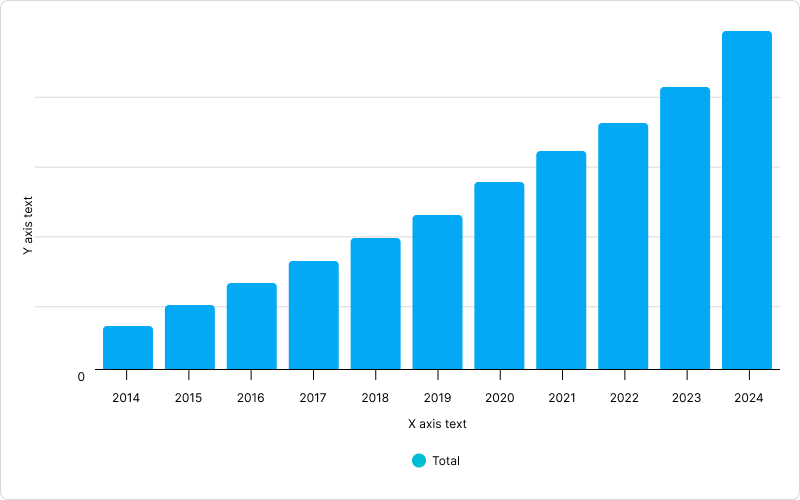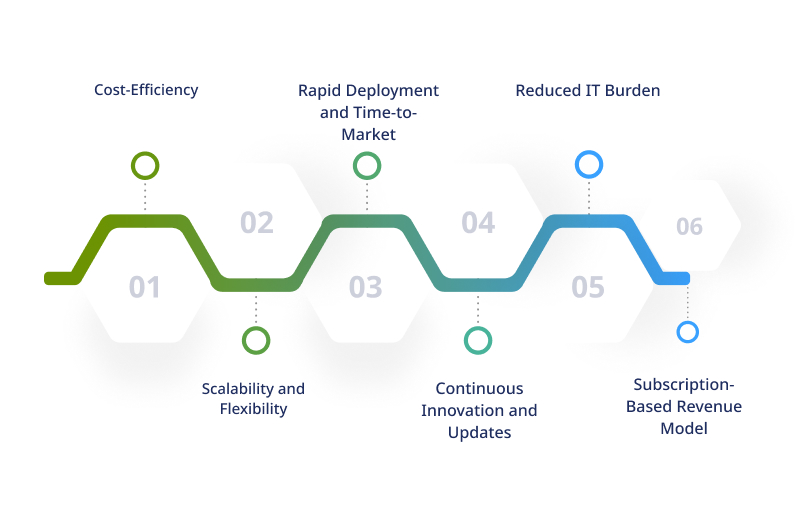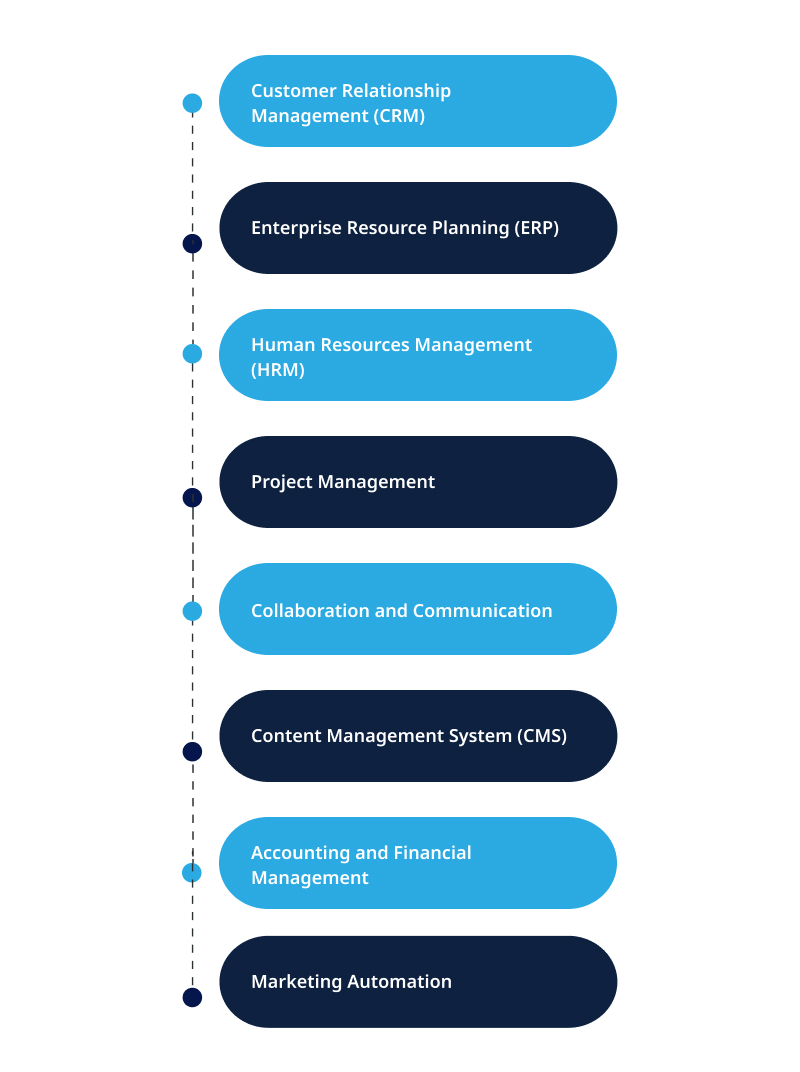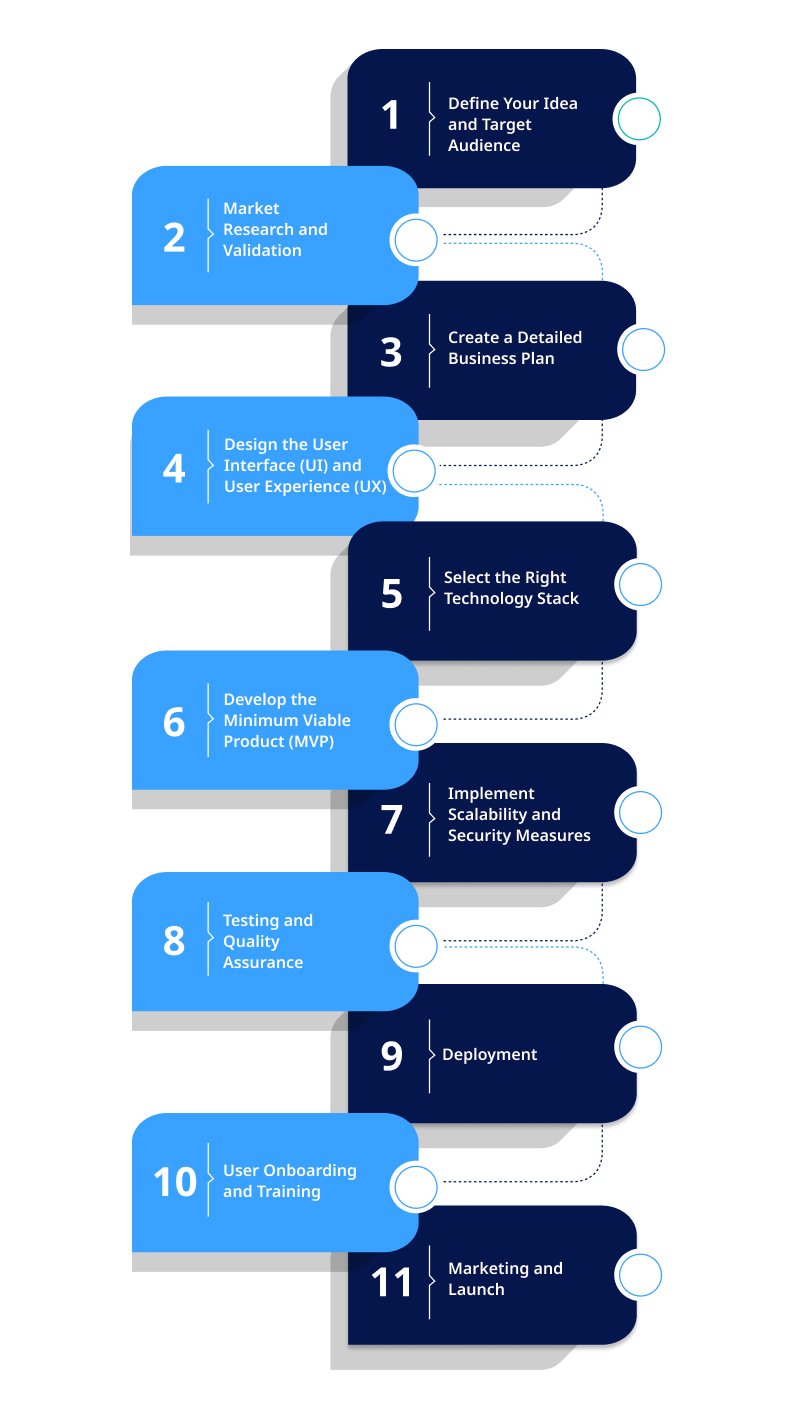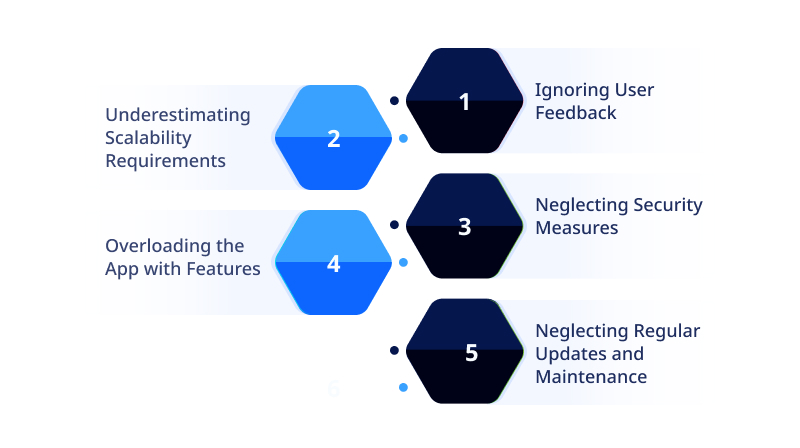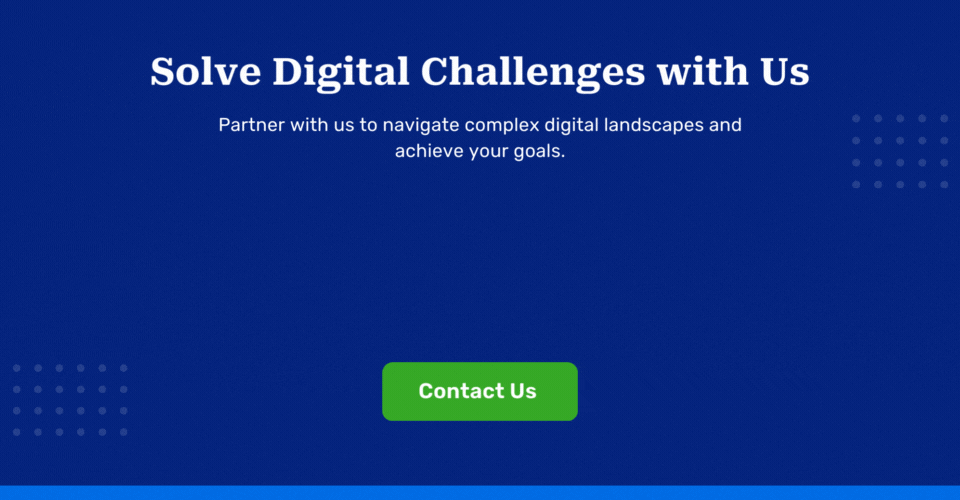Unsure about choosing the new SaaS product development for your business?
Well, with so many factors to consider – from development costs to potential customer adoption – the decision can be overwhelming and stressful. Additionally, investing time and resources into a product can be costly and may not be successful. Therefore, it’s necessary to know the steps you can take to help your business in correct SaaS-based product development.
Read our blog to solve your confusion and get a comprehensive analysis of your business goals, target market, and potential ROI to give you a clear picture of the potential success of your product.
Table of Contents
SaaS – The Global Market Overview
Software as a Service (SaaS) is a public cloud service that offers software programs for download via the Internet in exchange for a monthly fee. Users do not need to install or maintain the software locally to access and use it using web browsers.
Software as a service (SaaS) offers ease and automatic updates by removing the need for software installation, purchase, and update. It frees up users’ time to utilize the program to fulfill their needs.
As per Statista:
- The Software as a Service (SaaS) market generated US$258.60 billion in revenue in 2023.
- Revenue is projected to expand at a compound annual growth rate (CAGR) of 7.69%, reaching a market volume of US$374.50 billion by 2028.
- The average expenditure per employee in the software as a service industry reached US$74.29 in 2023.
Businesses that offer these kinds of cloud-based software resources and services to individuals, enterprises, and organizations are included in the Software as a Service (SaaS) market.
Microsoft Office 365, a subscription-based software as a service (SaaS) suite of programs that includes Word, Excel, and PowerPoint that can be accessed through a web browser, is a common example of this kind of service.
Importance of SaaS Product Development for Business Growth
Organizations seeking growth and resilience must strategically employ Software as a Service (SaaS) product development. Let’s examine the benefits of SaaS for promoting company growth.
Cost-Efficiency: SaaS product development is essential for business expansion because of its built-in cost-effectiveness. Conventional software development frequently entails high upfront infrastructure, maintenance, and license expenditures.
In contrast, SaaS offers a subscription-based approach that lets organizations pay for what they use, eliminating the need for large hardware and infrastructure investments.
With its economic strategy, companies can more effectively manage resources, rerouting money for marketing, innovation, and other growth-oriented projects. Regular maintenance and updates are also frequently covered by the subscription, which eases the load on internal IT workers and further lowers long-term costs.
Scalability and Flexibility: SaaS product development addresses the changing nature of contemporary markets by offering enterprises unmatched scalability and flexibility. Software requirements change as businesses expand, and SaaS solutions are made to grow with them easily.
Organizations can swiftly adjust to changing needs without major changes to their operations because cloud-based architecture makes it easy to scale up or down resources in response to demand.
Its scalability also makes introducing features to match changing user expectations or enter new markets easier. SaaS solutions also provide accessible flexibility, enabling users to access the program from any location with an internet connection.
Rapid Deployment and Time-to-Market: SaaS (Software as a Service) product development is important because it helps reduce time-to-market and enables quick deployment in the fast-paced business world.
Unlike traditional software development models that require time-consuming installation procedures and maintenance, SaaS products can be quickly downloaded and deployed via the cloud.
With its rapid deployment, businesses can launch new features, react swiftly to opportunities, and adjust to shifting market demands.
Continuous Innovation and Updates: Continuous innovation and seamless upgrades are two other important aspects of SaaS product development that highlight their value for business success.
Subscription-based SaaS applications enable developers to iteratively improve features in response to customer feedback, technical developments, and changing market trends.
With this ongoing innovation, companies adopting SaaS solutions are not limited to static software versions and can instead take advantage of a dynamic, constantly changing toolkit.
Frequent updates and enhancements promote client happiness and loyalty by keeping the product secure, up-to-date, and compliant with industry standards.
Reduced IT Burden: Businesses can strategically lower their IT burden by embracing Software as a Service (SaaS) product development. In the past, businesses had to handle and keep up a large IT infrastructure, which included servers, databases, and software upgrades.
With SaaS, the SaaS provider assumes accountability for software and infrastructure upkeep. Companies may concentrate on their core skills through this shift and use the specialist SaaS providers’ knowledge to guarantee the best system performance, security, and scalability.
The decreased IT load promotes a more flexible and adaptable corporate environment, which improves operational efficiency and enables firms to spend resources more strategically.
Subscription-Based Revenue Model: When it comes to software, SaaS works differently from typical software sales. Instead of requiring large upfront payments, clients pay a regular price to access the product and updates.
Businesses should expect a more steady and consistent revenue stream with this arrangement. By balancing the company’s financial goals with the value that it provides to clients over time, it promotes client retention and happiness.
Additionally, a more scalable and sustainable business model is made possible by the subscription-based model, which enables companies to plan and invest in ongoing innovation, customer support, and product improvements—all of which ultimately contribute to long-term business success.
Ready to explore the world of SaaS product development? Connect with our experts to analyze your goals and discover if SaaS is your right choice.
Types of SaaS Applications
Software as a Service (SaaS) applications have become essential tools for firms transitioning to cloud-based solutions, simplifying different organizational activities.
Let’s examine some of the most important SaaS product application types and how they transform business operations in the digital age.
1. Customer Relationship Management (CRM)
Applications for CRM software as a service (SaaS) are made to assist companies in managing and maximizing their contacts with clients for the client lifecycle.
These platforms give companies access to a central database where they may handle leads, prospects, and customer support contacts, store client data, and keep track of previous communications.
2. Enterprise Resource Planning (ERP)
ERP SaaS solutions are all-inclusive platforms that combine different organizational business processes and operations into a single, cohesive system.
The applications are designed to optimize productivity, simplify processes, and offer instantaneous insight into several corporate domains, including finance, human resources, supply chain, and manufacturing.
3. Human Resources Management (HRM)
Human Resources Management SaaS apps are software programs that run on the cloud and are intended to improve and expedite several HR procedures inside a company. It includes features like:
- Payroll processing
- Benefits administration
- Time and attendance tracking
- Performance management
- Employee onboarding
These apps improve efficiency, cooperation, and data accessibility for HR professionals and employees by centralizing HR operations in a cloud environment.
4. Project Management
Project Management SaaS applications are cloud-based tools specifically developed to facilitate and enhance project planning, execution, and collaboration.
Task management, project scheduling, document sharing, team communication, and progress tracking are just a few of the functionality offered by these tools.
Project management software (SaaS) tools enable teams to work together in real-time by utilizing the cloud’s capabilities. It ensures efficient coordination and visibility into project schedules, activities, and milestones.
5. Collaboration and Communication
Working together and communicating SaaS apps are instruments made to improve communication and collaboration among users inside a company. It includes features like:
- File sharing
- Video conferencing
- Real-time texting
- Group document editing
Slack, Microsoft Teams, and Zoom are a few SaaS examples of communication and collaboration. They easily interchange information and promote a more cohesive and effective work atmosphere.
6. Content Management System (CMS)
One SaaS program that lets users produce, manage, and distribute digital information on the web is a content management system (CMS).
Information management Systems (CMS) streamline the process of developing and managing websites by offering an intuitive interface for creating and changing information.
They enable users—even those with little technological expertise—to handle multimedia effectively, update website content, and arrange information. CMS SaaS apps that are widely used include Joomla, Drupal, and WordPress.
7. Accounting and Financial Management
Cloud-based software as a service (SaaS) programs for accounting and financial management are made to automate and simplify financial operations for companies. This includes features like:
- Cost monitoring
- Bookkeeping
- Invoicing
- Financial reporting
- Payroll management
These SaaS solutions enable enterprises to effectively manage their financial operations and make defensible decisions by centralizing financial data and offering real-time insights.
8. Marketing Automation
Businesses can automate and optimize many parts of their marketing operations using Marketing Automation Software as a Service (SaaS) technologies. Features like:
- Email marketing
- Lead nurturing
- Campaign management
- Customer segmentation
- Analytics
Businesses can use marketing automation to personalize communications with prospects and consumers, automate tedious operations, and track the effectiveness of marketing efforts.
Organizations can increase productivity, send more focused messages, and develop successful marketing strategies by automating these procedures.
Deciding on SaaS product development can be daunting. Let our experienced team guide you through the decision-making process.
Steps to Build a SaaS Product
A strategic and all-encompassing approach is necessary when developing a Software as a Service (SaaS) solution. Every stage, from formulating the original concept to the final launch, is critical to developing a profitable SaaS enterprise.
Here’s a breakdown of the key steps involved:
1. Define Your Idea and Target Audience
Clearly state the issue that your SaaS solution seeks to resolve. Describe the main attributes and features that will help with the highlighted problems. Ensure your concept has a distinct value proposition and fits a market need.
- Recognize and categorize your target audience.
- Determine the characteristics, inclinations, and issues that the users of your SaaS product will most likely have.
- Make sure your features align with the needs of this audience by customizing your product to suit their needs.
2. Market Research and Validation
To comprehend the competitive environment, carry out in-depth market research. Follow the below steps:
- Determine which options are currently on the market and evaluate their advantages and disadvantages.
- Learn about consumer preferences, market trends, and possible holes your SaaS solution can cover.
- Get input from your intended market to validate your SaaS product concept.
Surveys, interviews, or developing a Minimum Viable Product (MVP) for preliminary testing can all be part of this process. To improve your product’s chances of being accepted by the market, validate hypotheses, get customer feedback, and make necessary revisions based on actual user experience.
3. Create a Detailed Business Plan
Building a thorough business plan is essential before starting the SaaS product development process. This strategy should include:
- A description of the SaaS product’s objectives, target market identification, competition analysis, and monetization approach.
- A thorough financial model with estimated costs, revenue sources, and a development and launch schedule.
A strong business plan gives prospective investors and stakeholders a clear picture of the product’s market positioning and possible return on investment. It acts as a roadmap for the development team.
4. Design the User Interface (UI) and User Experience (UX)
The success of a SaaS product is intricately linked to the satisfaction and engagement of its users. It is crucial to design a seamless User Experience (UX) in addition to an intuitive and aesthetically pleasing User Interface (UI). This entails:
- Comprehending the target audience’s requirements and preferences, developing wireframes and prototypes, and iterating in response to user feedback.
- Well-designed user interfaces (UIs) make it easy for users to traverse a platform, and well-thought-out UX designs optimize the user experience from onboarding to regular usage.
- Devoting time and energy to UI/UX design increases market competitiveness and the product’s long-term success while improving customer satisfaction.
5. Select the Right Technology Stack
Selecting an appropriate technology stack is fundamental in developing a prosperous Software as a Service (SaaS) offering. The set of databases, frameworks, libraries, and programming languages that will be utilized to create the product is known as the technological stack.
A thorough evaluation of variables, including scalability, performance, security, and the particular needs of the SaaS application are all part of the decision process.
For example, a project management tool and a data analytics-focused SaaS offering would need different technological stacks.
Developers may guarantee that the SaaS product is not only dependable and efficient, but also in line with the long-term objectives and requirements of the company by choosing the right technological stack.
6. Develop the Minimum Viable Product (MVP)
A key component of the agile and iterative methodology frequently used in SaaS product development is creating a Minimum Viable Product (MVP).
The MVP is a condensed product with all the functionality needed to meet the target market’s primary needs. Developers can speed up the product’s time to market and get insightful input from early consumers by concentrating on important functionality.
Using an iterative development process, the final product is guaranteed to closely match consumer expectations and improve continuously based on user input.
Creating an MVP reduces the risk of devoting significant resources to features that might not be well-received by customers or satisfy market demands while also hastening the product launch.
7. Implement Scalability and Security Measures
Prioritizing scalability and security throughout the development process is essential in creating a Software as a Service (SaaS) offering. The SaaS product must be scalable to accommodate an expanding user base and more work without sacrificing functionality.
This calls for a flexible architecture, leveraging cloud services and optimizing databases for seamless expansion. To protect sensitive user data, security measures must be incorporated simultaneously.
Implementing encryption mechanisms, using safe coding techniques, and updating security features is crucial. A solid SaaS product that satisfies present needs and can develop in the future while preserving data integrity and user trust must strike a balance between scalability and security.
8. Testing and Quality Assurance
To guarantee a flawless user experience, comprehensive testing and quality assurance are essential stages in the lifecycle of a SaaS product development. Thorough testing covers various aspects, such as user interface, security, performance, and functionality.
Quality assurance efforts aim to find and fix defects, malfunctions, or other problems that might impair the product’s functionality. This procedure can be sped up with automated testing tools, enabling thorough inspections and quicker feedback loops.
Furthermore, conducting beta testing with a specific user group yields insightful observations and practical input. Developers may provide a dependable, error-free SaaS product that satisfies customer expectations and lays the groundwork for long-term success and great user experiences by prioritizing testing and quality assurance.
9. Deployment
The crucial deployment stage occurs when a Software as a Service (SaaS) product has finished its development phase. Making the product available to users is deployment, usually via cloud-based platforms. To protect user data, this phase entails:
- Installing servers, guaranteeing scalability, and implementing the required security measures.
- A smooth deployment procedure is necessary for a satisfying user experience because any hiccups or downtime during this stage can affect user confidence and contentment.
For a deployment to be successful, the development, operations, and support teams must carefully plan and coordinate to guarantee a seamless transfer from the development environment to the live environment.
10. User Onboarding and Training
User onboarding and training are pivotal in the SaaS product lifecycle, influencing user adoption and satisfaction. Leading users through the initial setup, highlighting important features, and showing them how to get value from the product are all part of an effective onboarding process.
This stage aims:
- To minimize obstacles and improve the user’s comprehension of the product’s functionalities.
- To have easily available training materials, such as guides, instructions, and customer service
- To guarantee that users can incorporate the SaaS product into their workflows fast and effectively.
An effective onboarding and training procedure helps maintain users and creates the groundwork for a satisfying long-term user experience.
11. Marketing and Launch
Marketing and launch are crucial in introducing a SaaS product to the target audience and maximizing its impact. It is important to have a strategic marketing plan in place to raise awareness, spark curiosity, and promote user acquisition. This includes:
- Choosing the right marketing channels, determining the target audience, and creating an appealing value offer.
- The product’s public debut is a meticulously planned occasion that announces its availability.
- The launch’s reach and impact can be increased via email campaigns, social media, digital marketing, and other promotional techniques.
After a product launch, continuous marketing campaigns are necessary to keep the momentum, draw in new customers, and address customer feedback for continued product development.
Don't navigate the SaaS landscape alone. Schedule a consultation to discover if SaaS product development aligns with your business objectives.
5 Common Mistakes to Avoid in SaaS App Development
Success in the ever-changing world of Software as a Service (SaaS) app development depends on avoiding typical traps. This section explores 5 common mistakes developers must know to guarantee SaaS apps’ smooth development and functioning.
1. Ignoring User Feedback
Mistake: When developing SaaS apps, paying attention to customer feedback is important to avoid producing a solution that falls short of what users want and need.
Solution: Create a strong feedback loop and actively solicit customer feedback at every stage of the development process. To guarantee a user-centric product, perform beta testing, interact with user reviews, and refine features based on helpful criticism.
2. Underestimating Scalability Requirements
Mistake: When user demand rises, a SaaS application’s scalability requirements may not be anticipated, resulting in performance problems and outages.
Solution: To proactively address scalability concerns, design the architecture to manage growth, use cloud-based solutions that enable easy scaling, and regularly test the application’s performance under various load situations.
3. Neglecting Security Measures
Mistake: When user demand rises, a SaaS application’s scalability requirements may not be anticipated, resulting in performance problems and outages.
Solution: To proactively address scalability concerns, design the architecture to manage growth, use cloud-based solutions that enable easy scaling, and regularly test the application’s performance under various load situations.
4. Overloading the App with Features
Mistake: Having too many features might overwhelm people and result in an interface that is cluttered and difficult to use. It has a detrimental effect on the user experience, making maintenance more difficult and possibly causing performance problems.
Solution: Put your attention on creating a simple, intuitive design. Sort important features into priority lists according to user input and demands. To ensure a seamless and effective user experience, regularly evaluate the app’s functionality and user engagement.
5. Neglecting Regular Updates and Maintenance
Mistake: When developing SaaS apps, it’s common to overlook routine maintenance and upgrades. Ignoring bugs, security flaws, and general performance problems can result in a worse user experience and eventually harm the app’s reputation.
Solution: Updates and maintenance should be handled proactively and methodically. Release updates frequently to fix errors, add new functionality, and improve security.
Create a routine maintenance program to guarantee the app’s durability and peak functionality, showing a dedication to continuous enhancement and user contentment.
How can PixelCrayons help Choose SaaS Product Development?
PixelCrayons can significantly aid in choosing SaaS product development by leveraging their expertise and experience in the field.
With a proven track record in delivering customized software solutions, we offer comprehensive SaaS development services tailored to meet specific business needs.
Our team of skilled developers and industry experts collaborates closely with clients to understand their requirements and high-performance SaaS products.
Connect with us for SaaS product development ensures a reliable partner dedicated to transforming ideas into successful, market-ready solutions.
Summing Up
The decision for a SaaS-based product development must be determined by carefully considering your company’s capabilities, resources, customer needs, and the existing market conditions.
Although the journey might pose some challenges, the advantages, such as high scalability, consistent revenue flow, easy access, and low initial cost, make it an attractive option. Thorough research, careful planning, and consistent effort are key to success.
Always remember your ultimate aim should align with solving customer issues and creating a worthwhile SaaS product with the help of a SaaS development company.

